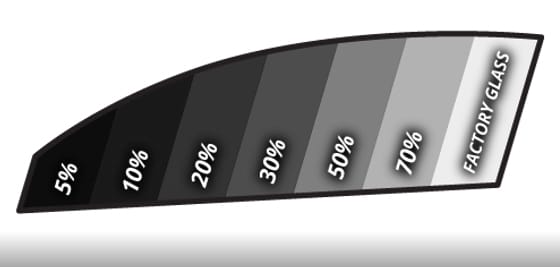Iowa was the 1st state in the U.S. to enact window tint laws. This was done in 1983 which set the standard for other states to follow. Ever since then, tint laws have been widely adapted all over the country.
The Iowa tint law lays down parameters for the installation and use of window tints on various commercially and privately owned vehicles.
In addition to stating whether or not window tints are acceptable, the law also highlights other nuances which have to do with window tint darkness, positioning, reflectivity, and colors.
Most law enforcement officials carry electrical devices that can measure window tint darkness. As long as the tint film you’ve chosen for your car complies with the law, you’ll be in the clear.
With that in mind, let’s get down to the brass tacks and explore what the window tint laws in Iowa are all about.
Is Window Tint Legal in Iowa?

Window tint is certainly not illegal in Iowa, although the rules are quite stringent when it comes to how dark the window tint can be.
You’re required to keep your windows as transparent as possible. The main purpose of this rule is that the driver and passengers should be identifiable from outside the vehicle.
This makes it necessary for you to find dependable manufacturers that follow these guidelines and advertise their products accurately.
Apart from light transmission, there are other guidelines that you need to follow. This has to do with how reflective your windows are after you install the tint.
Many car owners like the look and functionality of mirror-like tints. If that sounds like you, be sure to go through the stipulated guidelines around this issue before you select a tint film for your car.
Also, you will need to ensure that you check the rules specific to the type of vehicle that you own, not to mention that windshield regulations and window regulations can differ too.
Permitted Window Tint Darkness

Visible light transmission (VLT) is a unit of measurement used to calculate how much light is able to travel through the window tint and into the vehicle.
If the VLT is relatively low, the light traveling into the car will also be low. For example, if the VLT is 6%, only 6% of the light will go through the tint. However, if the VLT is 80%, 80% of the light will enter.
Every state, including Iowa, has stipulated guidelines on how dark or transparent your tinted windows should be.
Sedans
Windshield: 70% VLT is essential.
Driver-side windows: 70% VLT is necessary.
Passenger-side windows: The tint can be of any level of darkness.
Rear window: The tint can be of any level of darkness.
SUVs and Vans

Windshield: 70% VLT is essential.
Driver-side windows: 70% VLT is necessary.
Passenger-side window: The tint can be of any level of darkness.
Rear window: The tint can be of any level of darkness.
Acceptable Tint Reflection
It’s worth noting that reflection is entirely different from window tint darkness or transparency.
Tint darkness is indicated by the amount of light that passes through into your car, whereas reflection has to do with the light that never makes it into the cabin.

Highly reflective tints make it difficult to look inside the car, which is why Iowa, along with all other states, has specific regulations around the use of reflective tint. However, these regulations are slightly vague.
The only stipulated criteria is that you should avoid overly reflective tints, and that everyone in the car should be identifiable when the windows are rolled up.
This applies to all the windows of your car, including the front and rear windshields.
Other Iowa Tint Rules You Need to Know
Here are some additional regulations for window tints.
Medical exemption: Since 2012, Iowa has stopped granting medical exemptions for special tints.
Color: There are no color-based restrictions.
Side mirror: There are no stated limitations here.
Certification: It is not crucial for companies to certify the film.
Sticker: You do not need to add any stickers.
Violation fine: You will be charged a fine of $127.50.
State of Iowa Info

Situated in the Midwest, Iowa (or the Hawkeye state) has a diverse economy in place, centering around agriculture, finance, manufacturing, information technology, and other industries.
Iowa is surrounded by the states of Illinois, Missouri, Wisconsin, Minnesota, and Nebraska. The state has 99 counties with several important towns and cities.
It is the 31st most populated state in the country and ranks 26th in terms of how large it is. It experiences both heat and cold at intense degrees.
Population: 3,193,079
Capital: Des Moines
Registered vehicles: 4,341,801
Total lane miles: 114,782
Number of highways: 9
Tint law references: Iowa Code: Motor Vehicles | Iowa Legislature
Medical exemption info: Iowa Window Tinting Standards

